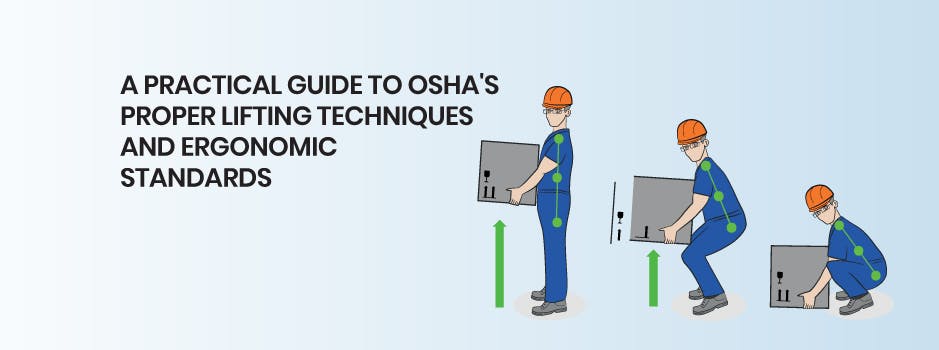OSHA Proper Lifting Techniques And Training
As everyone thinks that lifting is risk-free activity but there are many hazards hidden in it. Research says that 75% of workers experience back injuries each year while performing lifting tasks. Back injury is the biggest illness that has a bad effect on the worker’s life, and this is the reason workers miss work.
Making sure that the employees have proper lifting techniques training that helps in making less illness to injuries. The biggest advantage of using OSHA-recommended lifting techniques teaches employees about the dangers while they are lifting and the importance of OSHA-safe lifting techniques no matter how heavy lifts they are lifting.
Are Proper Lifting Techniques OSHA Important And Required?
OSHA has no such standards that are related to ergonomic lifting and proper workplace lifting techniques OSHA. This means there are no safe lifting techniques OSHA recommends.
Safe lifting techniques and ergonomic lifting fall under OSHA general duty clause, and it requires employers to protect the workers from reorganized and serious workplace hazards. For this, you have to employ any useful and feasible methods that are necessary to end the dangers and injuries like employers should provide OSHA 10 and OSHA 30 hour training to their employees.
Proper Lifting Techniques OSHA
Below are the proper safe lifting techniques recommended by OSHA that may be helpful in reducing injuries and other accidents.
1. Plan Ahead
Before lifting the lifts, it is very important to check your surrounding and paths to make sure that the working area is flat, free from problems, and dry. First, plan where you will place the object and how you will be going there. Then check the object's weight and see whether it is safe or not and whether it can be lifted by you alone or by a two-man lift.
2. Warm Up And Stretch
Stretching and warming up before lifting define the factors and chances of injuries through the workloads. Make sure to stretch your back and legs to warm up the muscles. The best stretches included for this are hamstring stretches and lower back rotations. Make sure to also have good blood flow to perform well. Also, do a few jumping jacks and run in place before you begin lifting.
3. Lift Safely
to lift safely, stand close to the load as much as possible so you don’t have to exert much force on your back to extend the distance. Keep your body upright while bending your knees so that your legs do the lifting instead of your back. Look straight, and keep your shoulder back to have a slight arch at your lower back.
4. Carry With A Good Grip
Get a good grip on the loads and then use your feet to change the direction. Take small steps as you go to avoid an accident. As soon as you change the direction lead your hips and then keep your shoulders in line with the hip movement. Try keeping the load close to your body with your elbows at your sides.
5. Set Down Safely
Lower the weight in reverse by lowering your legs. Keep the weight close to your body and your head up. Tight your stomach muscles and the weight close to your body. It may look like it is the easy part but you can have injured yourself. Sit safely with the loads you are picking up and then free them.
Avoid Dangerous Activities While Lifting Weights
Below are the tips and activities to avoid while you are lifting weights to avoid injuries:
- Don’t hold your breath
- Working or lifting while you are fatigued
- Lifting the weights above the shoulder level
- Turning or twisting your body while lifting weights
- Attempting to carry a load that is too large or heavy for a single man
- Don’t bend but rather squat down to the weighs
- Don’t rush through the process
- Use the grip with 1-2 fingers
- Make your vision focused while carrying the weights
Lifting And Material Handling Regulations
There are many more lifting and material handling regulations that should be kept in mind while lifting weights:
- Make sure to push the objects than pull as it is the safer act
- Limit the weight you are lifting and ensure they are no more than 50 pounds. If lifting weights heavier than 50 pounds, use two or more men to help you. If the weight is more than 100lbs then use machines for that.
- Use PPE where needed such as good boots, gloves, and other accessories to avoid injuries.
- Try using materials that have good packaging with proper handholds that are easy to handle the lifts.
- Don’t use awkward postures such as crawling by tables, racks, and others. Stay in the proper posture to avoid injuries.
Why are lifting ergonomics important?
Back injuries are being increased day by day and 75% of workplace injuries are occurring during the lifting task. Every year 2 million back injuries are occurring in the united states and one million back injuries are recorded in the workplace.
Back pain is bringing chronic and disabling in 5% of the cases and up to 44% of the people are initially recovering and having a reoccurrence within a year. Put the back injuries all together as they are the source of disability. After all, 5% of the million is 50,000 disabling and chronic cases of back pain. The consequences are very expensive for employers and in workers' claims, days always from work and losing productivity due to injuries.
Conclusion
Firstly, check the lifting task for safety and know how much weight you can lift, and make sure that the load does not exceed your capability. Also, make sure that the path is good and the floor is dry. Preparation and planning are important aspects of ergonomic lifting. Once you have planned for the lifting ergonomics, it will reduce the risk of injuries and accidents at the workplace.

